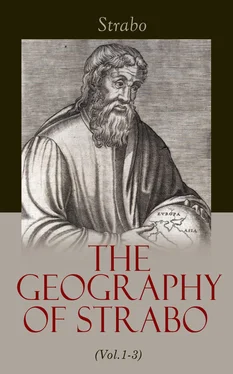Strabo - The Geography of Strabo (Vol.1-3)
Здесь есть возможность читать онлайн «Strabo - The Geography of Strabo (Vol.1-3)» — ознакомительный отрывок электронной книги совершенно бесплатно, а после прочтения отрывка купить полную версию. В некоторых случаях можно слушать аудио, скачать через торрент в формате fb2 и присутствует краткое содержание. Жанр: unrecognised, на английском языке. Описание произведения, (предисловие) а так же отзывы посетителей доступны на портале библиотеки ЛибКат.
- Название:The Geography of Strabo (Vol.1-3)
- Автор:
- Жанр:
- Год:неизвестен
- ISBN:нет данных
- Рейтинг книги:3 / 5. Голосов: 1
-
Избранное:Добавить в избранное
- Отзывы:
-
Ваша оценка:
- 60
- 1
- 2
- 3
- 4
- 5
The Geography of Strabo (Vol.1-3): краткое содержание, описание и аннотация
Предлагаем к чтению аннотацию, описание, краткое содержание или предисловие (зависит от того, что написал сам автор книги «The Geography of Strabo (Vol.1-3)»). Если вы не нашли необходимую информацию о книге — напишите в комментариях, мы постараемся отыскать её.
The Geography of Strabo (Vol.1-3) — читать онлайн ознакомительный отрывок
Ниже представлен текст книги, разбитый по страницам. Система сохранения места последней прочитанной страницы, позволяет с удобством читать онлайн бесплатно книгу «The Geography of Strabo (Vol.1-3)», без необходимости каждый раз заново искать на чём Вы остановились. Поставьте закладку, и сможете в любой момент перейти на страницу, на которой закончили чтение.
Интервал:
Закладка:
21. Those who desire to instil into us that more perfect freedom from [ignorant] wonder, which Democritus and all other philosophers so highly extol, should add the changes which have been produced by the migrations of various tribes: we should thus be inspired with courage, steadiness, and composure. For instance, the Western Iberians, 426removed to the regions beyond the Euxine and Colchis, being separated from Armenia, according to Apollodorus, by the Araxes, 427but rather by the Cyrus 428and Moschican mountains. 429The expedition of the Egyptians into Ethiopia 430and Colchis. The migration of the Heneti, 431who passed from Paphlagonia into the country bordering on the Adriatic Gulf. Similar emigrations were also undertaken by the nations of Greece, the Ionians, Dorians, Achaians, and Æolians; and the Ænians, 432now next neighbours to the Ætolians, formerly dwelt near Dotium 433and Ossa, beyond the Perrhæbi; 434the Perrhæbi too are but wanderers here themselves. Our present work furnishes numerous instances of the same kind. Some of these are familiar to most readers, but the migrations of the Carians, the Treres, the Teucrians, and the Galatæ or Gauls, 435are not so generally known. Nor yet for the most part are the expeditions of their chiefs, for instance, Madys the Scythian, Tearko the Ethiopian, Cobus of Trerus, Sesostris and Psammeticus the Egyptians; nor are those of the Persians from Cyrus to Xerxes familiar to every one. The Kimmerians, or a separate tribe of them, called the Treres, have frequently overrun the countries to the right of the Euxine and those adjacent to them, bursting now into Paphlagonia, now into Phrygia, as they did when, according to report, Midas 436came to his death by drinking bull’s blood. Lygdamis led his followers into Lydia, passed through Ionia, took Sardis, but was slain in Cilicia. The Kimmerians and Treres frequently made similar incursions, until at last, as it is reported, these latter, together with [their chief] Cobus, were driven out by Madys, king of the “Scythians.” 437But enough has been said in this place on the general history of the earth, as each country will have a particular account.
22. We must now return to the point whence we digressed. Herodotus having observed that there could be no such people as Hyperboreans, inasmuch as there were no Hypernotii, 438Eratosthenes calls this argument ridiculous, and compares it to the sophism, that there are no epichærekaki, 439inasmuch as there are no epichæragathi; 440[adding] perhaps there are Hypernotii; since at all events in Ethiopia Notus does not blow, although lower down it does.
It would indeed be strange, since winds blow under every latitude, and especially the southern wind called Notus, if any region could be found where this latter was not felt. On the contrary, not only does Ethiopia experience our Notus, but also the whole country which lies above as far as the equator. 441
If Herodotus must be blamed at all, it is for supposing that the Hyperboreans were so named in consequence of Boreas, or the north wind, not blowing upon them. The poets are allowed much licence in their modes of expression; but their commentators, who endeavour always to give us the correct view, tell us that the people who dwelt in the extreme north, were styled Hyperboreans. The pole is the boundary of the northern winds, and the equator of the southern; these winds have no other limit.
23. Eratosthenes next finds fault with the writers who fill their narrative with stories evidently feigned and impossible; some as mere fable, but others as history, which did not deserve mention. In the discussion of a subject like his, he should not have wasted his time about such trifles. Such is the way in which this writer completes the First Book of his Memoirs.
CHAPTER IV.
Table of Contents
1. In his Second Book Eratosthenes endeavours to correct some errors in geography, and offers his own views on the subject, any mistakes in which we shall endeavour in our turn to set right. He is correct in saying that the inductions of mathematics and natural philosophy should be employed, and that if the earth is spheroidal like the universe, it is inhabited in all parts; together with some other things of this nature. Later writers do not agree with him as to the size of the earth, 442nor admit his measurement. However Hipparchus, when noting the celestial appearances for each particular locality, adopts his admeasurements, saying that those taken for the meridian of Meroe, 443Alexandria, and the Dnieper, differ but very slightly from the truth. Eratosthenes then enters into a long discussion concerning the figure of the globe, proving that the form of the earth together with the water is spheroidal, as also the heavens. This however we imagine was foreign to his purpose, and should have been disposed of in the compass of a few words.
2. After this he proceeds to determine the breadth of the habitable earth: he tells us, that measuring from the meridian of Meroe 444to Alexandria, there are 10,000 stadia.
From thence to the Hellespont 445about 8100. Again; from thence to the Dnieper, 5000; and thence to the parallel of Thule, 446which Pytheas says is six days’ sail north from Britain, and near the Frozen Sea, other 11,500. To which if we add 3400 stadia above Meroe in order to include the Island of the Egyptians, 447the Cinnamon country, and Taprobane, 448there will be in all 38,000 stadia.
3. We will let pass the rest of his distances, since they are something near,—but that the Dnieper is under the same parallel as Thule, what man in his senses could ever agree to this? Pytheas, who has given us the history of Thule, is known to be a man upon whom no reliance can be placed, and other writers who have seen Britain and Ierne, 449although they tell us of many small islands round Britain, make no mention whatever of Thule. The length of Britain itself is nearly the same as that of Keltica, 450opposite to which it extends. Altogether it is not more than 5000 stadia in length, its outermost points corresponding to those of the opposite continent. In fact the extreme points of the two countries lie opposite to each other, the eastern extremity to the eastern, and the western to the western: the eastern points are situated so close as to be within sight of each other, both at Kent and at the mouths of the Rhine. But Pytheas tells us that the island [of Britain] is more than 20,000 stadia in length, and that Kent is some days’ sail from France. With regard to the locality of the Ostimii, and the countries beyond the Rhine, 451as far as Scythia, he is altogether mistaken. The veracity of a writer who has been thus false in describing countries with which we are well acquainted, should not be too much trusted in regard to unknown places.
4. Further, Hipparchus and many others are of opinion that the parallel of latitude of the Dnieper does not differ from that of Britain; since that of Byzantium and Marseilles are the same. The degree of shadow from the gnomon which Pytheas states he observed at Marseilles being exactly equal to that which Hipparchus says he found at Byzantium; the periods of observation being in both cases similar. 452Now from Marseilles to the centre of Britain is not more than 5000 stadia; and if from the centre of Britain we advance north not more than 4000 stadia, we arrive at a temperature in which it is scarcely possible to exist. Such indeed is that of Ierne. 453Consequently the far region in which Eratosthenes places Thule must be totally uninhabitable. By what guess-work he arrived at the conclusion that between the latitude of Thule and the Dnieper there was a distance of 11,500 stadia I am unable to divine.
5. Eratosthenes being mistaken as to the breadth [of the habitable earth], is necessarily wrong as to its length. The most accurate observers, both ancient and modern, agree that the known length of the habitable earth is more than twice its breadth. Its length I take to be from the [eastern] extremity of India 454to the [westernmost] point of Spain; 455and its breadth from [the south of] Ethiopia to the latitude of Ierne. Eratosthenes, as we have said, reckoning its breadth from the extremity of Ethiopia to Thule, was forced to extend its length beyond the true limits, that he might make it more than twice as long as the breadth he had assigned to it. He says that India, measured where it is narrowest, 456is 16,000 stadia to the river Indus. If measured from its most prominent capes it extends 3000 more. 457Thence to the Caspian Gates, 14,000. From the Caspian Gates to the Euphrates, 45810,000. From the Euphrates to the Nile, 5000. 459Thence to the Canopic 460mouth, 1300. From the Canopic mouth to Carthage, 13,500. From thence to the Pillars at least 8000. Which make in all 70,800 stadia. To these [he says] should be added the curvature of Europe beyond the Pillars of Hercules, fronting the Iberians, and inclining west, not less than 3000 stadia, and the headlands, including that of the Ostimii, named Cabæum, 461and the adjoining islands, the last of which, named Uxisama, 462is distant, according to Pytheas, a three days’ sail. But he added nothing to its length by enumerating these last, viz. the headlands, including that of the Ostimii, the island of Uxisama, and the rest; they are not situated so as affect the length of the earth, for they all lie to the north, and belong to Keltica, not to Iberia; indeed it seems but an invention of Pytheas. Lastly, to fall in with the general opinion that the breadth ought not 463to exceed half the length, he adds to the stated measure of its length 2000 stadia west, and as many east.
Читать дальшеИнтервал:
Закладка:
Похожие книги на «The Geography of Strabo (Vol.1-3)»
Представляем Вашему вниманию похожие книги на «The Geography of Strabo (Vol.1-3)» списком для выбора. Мы отобрали схожую по названию и смыслу литературу в надежде предоставить читателям больше вариантов отыскать новые, интересные, ещё непрочитанные произведения.
Обсуждение, отзывы о книге «The Geography of Strabo (Vol.1-3)» и просто собственные мнения читателей. Оставьте ваши комментарии, напишите, что Вы думаете о произведении, его смысле или главных героях. Укажите что конкретно понравилось, а что нет, и почему Вы так считаете.












![Anne Blunt - A Pilgrimage to Nejd, the Cradle of the Arab Race. Vol. 2 [of 2]](/books/750183/anne-blunt-a-pilgrimage-to-nejd-the-cradle-of-the-thumb.webp)